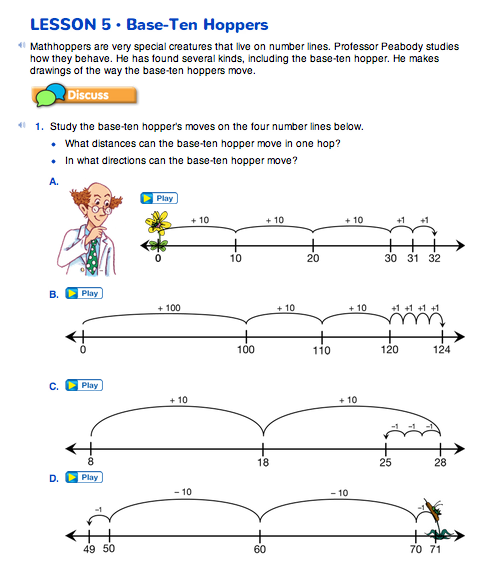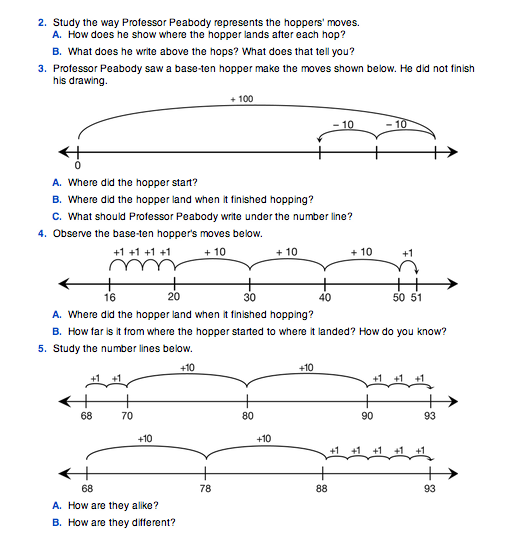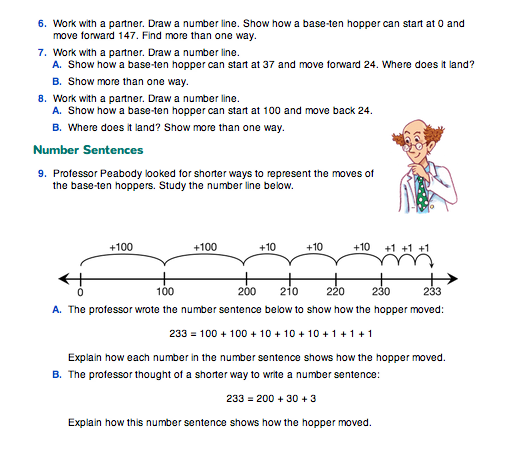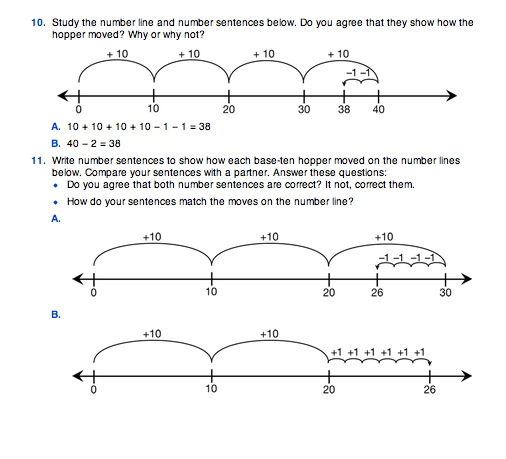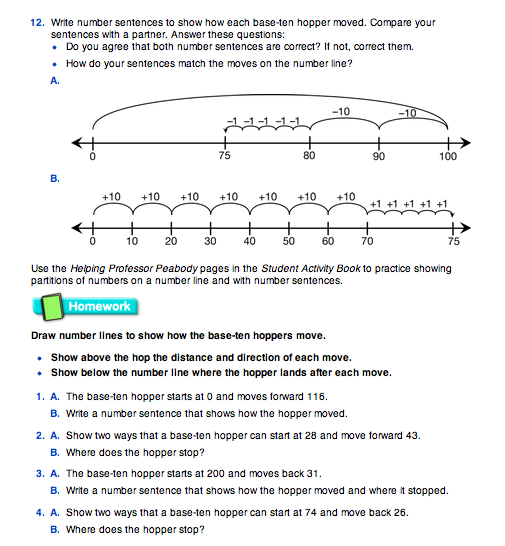Analyze Base-Ten Hopper Moves. Display the first Base-Ten Hoppers page in the Student Guide to introduce the base-ten hoppers. Ask students to work in pairs to study the moves that a base-ten hopper can make and to complete Questions 1 and 2.
Upon completion of the questions tell students they are Professor Peabody's assistants.
Ask pairs to do the following:
- Prepare an oral report for the rest of the class on your observations. Your report should include how the base-ten hoppers move and how Professor Peabody records their movements.
A possible report follows:
“Base-ten hoppers can make hops with distances of one, ten, and one hundred on the number line. These are the only distances on the four number lines. Base-ten hoppers can go forward or backward. You can see that sometimes the hoppers go forward and sometimes they go backward. He shows a forward hop by putting plus and the number of spaces hopped. He shows a backward hop with minus and the number of spaces hopped. Professor Peabody shows where the hopper lands after each hop by writing the number under the number line.”
Ask students to share their oral reports. Encourage those listening to ask questions of those reporting so that everyone understands how the hoppers can move and how to record the movements.

This lesson provides a context for students to develop skills composing and decomposing numbers. Number lines serve as tools for developing mental images of numbers decomposed into groups of ones, tens, and hundreds. The goal is for students to develop math skills that will allow them to develop flexible and efficient strategies to estimate, add, and subtract mentally (or with the aid of a number line). For example, to add 43 and 39, students can think of moves on a number line that start at 43. Since 39 is close to 40, move forward 4 tens, and then back one: 43, 53, 63, 73, 83, and back one to 82. They can visualize:

Other students may choose to start at 43, count on 7 until they get to the next ten (50), count on 3 tens (60, 70, 80), and then count on 2 more (81, 82).

Place the emphasis of this lesson on using the number line to break apart and combine numbers using hundreds, tens, and ones in flexible and efficient ways. Focus on supporting this kind of thinking. Students should learn to represent their moves on the number lines so that others can understand their thinking. However, developing consistent notation is not as important as developing flexible thinking.
Use the following prompts to further students' thinking:
- How are the base-ten hopper's moves like the base-ten pieces? (A hop of one is like a bit, a hop of ten is like a skinny, and a hop of 100 is like using a flat.)
- Do you think base-ten hoppers can make a one thousand hop? Why or why not? (Possible response: A hop of one thousand would be like using a pack and the base-ten hopper can hop one hundred like a flat, ten like a skinny, and one like a bit, so it should be able to go a thousand, too.)
- How far did the base-ten hopper on Number Line A move? How do you know? (It moved 32. It started at 0 and landed on 32. It made three hops of 10 and two hops of 1. That's the same as 32.)
- Write a number sentence to show how the hopper moved on Number Line A. (10 + 10 + 10 + 2 = 32)
- How far did the base-ten hopper on Number Line B move? Write a number sentence that shows how it moved. (124; 100 + 10 + 10 + 1 + 1 + 1 + 1 = 124.)
- Where did the base-ten hopper on Number Line C start? Where did it land after its last hop? (It started at 8 and ended up at 25.)
- How far is it from where the base-ten hopper on Number Line C started to where it landed? How do you know? (Possible response: The distance from where it started to where it landed is 17. It moved ten forward twice, or 20. Then it moved back three. 20 – 3 = 17.)
- Is there another way that a base-ten hopper can start at 8 and move 17 forward? (It can move forward ten and then one 7 times.)
- Where did the hopper start on Number Line D? (It started at 71.)
- Describe how the base-ten hopper moved on Number Line D. (It moved back one, then back ten twice, then back one, and ended on 49.)
- How far did it move? How do you know? (It moved 22. Possible response: Two tens and two ones make 22.)
Use Base-Ten Hoppers. Ask students to work in pairs to complete Questions 3–8 in the Student Guide.
Questions 3–4 help students understand how they can show moves on the number line so that someone else can see where the hopper starts, the distance and direction of each move, and the final stopping point.
Question 5 shows two ways to start at 68 and move forward 25. Students first compare the two sets of moves.
- How are the two number lines alike? (Both hoppers start at 68 and move forward 25 hops to 93.)
- How are they different? (The first hopper breaks 5 into 2 and 3, so that it can move forward two hops to get to the nearest ten (68, 69, 70). Next it can hop two tens from 70 (80, 90) and then hop by ones the last three hops to 93. The second hopper starts counting by tens right away and then counts on the 5 ones (68, 78, 88, 89, 90, 91, 92, 93).)
- Which method do you find easier and why? (Responses will vary.)
Questions 6–8 ask students to find more than one way to show how a hopper can move various distances on number lines. Ask more than one pair of students to present their number lines for each question. Then ask other students to describe the moves. Encourage them to question the students who presented their number lines if the moves are not clear or correct. Ask students who drew the number lines to explain why they made the moves they did.
Number Sentences. To connect the moves on the number line to number sentences, complete Questions 9 in the Number Sentences section together as a class and discuss.
- How does each number in Professor Peabody's number sentence show how the hopper moved? (The hopper made a jump for each number in the number sentence.)
- How does the professor's shorter number sentence, 233 = 200 + 30 + 3, show how the hopper
moved? (He wrote 200 for the 2 hops of 100, 30 for the 3 hops of 10, and 3 for the 3 hops of one.)
Assign Questions 10–12 to student pairs. In Question 12, students will compare number sentences with a partner explaining how the numbers in their sentences match the moves on the number lines.















